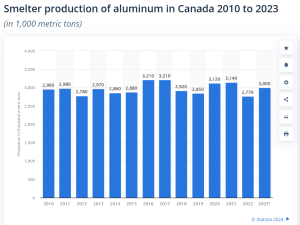Canada’s steel and aluminum industries are sounding the alarm over what they describe as an “existential threat” while urging the federal government to align with the United States and Mexico in imposing tariffs on Chinese steel and aluminum to prevent market dumping. This plea comes amid growing concerns that Canada could become a conduit for Chinese products circumventing American and Mexican tariffs.
Why Canada’s Steel and Aluminum Industries Raise The Alarm
Canada currently produces primary aluminum—rather than recycled aluminum—at eight smelters located in Quebec and one in Kitimat, British Columbia. These facilities are owned by three major companies: Alcoa, Aluminerie Alouette, and Rio Tinto. Rio Tinto also operates an alumina refinery in Vaudreuil, Quebec.
The Canadian aluminum industry produces a wide range of products, including doors, windows, house siding, beverage cans, foil products, cooking utensils, and electrical wiring.
As of 2022, Canada ranked as the world’s 4th-largest producer of primary aluminum, following China, India, and Russia. The North American country produced about 3.0 million tonnes of primary aluminum in 2022, which accounts for about 4.4 percent of global production. In contrast, China alone produces more than half of the world’s aluminum.
A notable advantage of Canada’s aluminum industry is its lower carbon footprint compared to other major producers, thanks to its reliance on renewable energy sources, particularly hydroelectric power.
In 2023, Canada’s smelter production of aluminum was estimated at around 3 million metric tons as seen below. Throughout the observed period, Canada’s aluminum production volume remained relatively stable. The country’s peak production occurred in both 2016 and 2017, when it reached 3.2 million metric tons.
How Significant Is Canada’s Aluminum Production and Export Market?
Canada is the world’s second-largest exporter of aluminum, with aluminum product exports totaling $18.2 billion in 2022. The United States is the primary market for these Canadian exports, making it a crucial partner in the aluminum trade. This close trade relationship underscores the importance of maintaining strong economic ties and competitive advantages in the aluminum industry.
However, the recent actions of the U.S. government of imposing tariffs on China imports spurred the industry’s interest to do the same.
Catherine Cobden, President and CEO of the Canadian Steel Producers Association (CSPA), emphasized the urgency of the issue during a press conference in Ottawa. She stressed the need for Canada to act in concert with its North American trade partners under the Canada-United States-Mexico Agreement (CUSMA).
“We can’t be the only CUSMA country that is not taking this serious action,” Cobden stated, highlighting the critical nature of the moment for Canada’s steel industry.
-
The CSPA represents 13 steel companies, including major players like Stelco, Algoma Steel Inc., and Rio Tinto.
The Canadian industry leaders’ call to action follows the U.S. government’s May announcement of a 25% tariff increase on Chinese steel and aluminum. Additionally, the U.S. has imposed higher tariffs on other Chinese products, including electric vehicles (EVs), semiconductors, critical minerals, and batteries.
In response, Mexico, in July, introduced a 10% tariff on aluminum and a 25% tariff on steel not produced within Mexico, in collaboration with the U.S. These measures aim to prevent Chinese producers from bypassing tariffs through Mexican trade routes.
The Implications of Urging Tariffs on Chinese Imports
The CSPA and the Aluminium Association of Canada are advocating for a 25% tariff on all Chinese steel products and most aluminum products entering Canada. This would mirror the recent U.S. decision to impose tariffs on 289 different Chinese steel and aluminum imports. Cobden stressed the urgency of the situation, warning that failure to act could result in job losses and hinder economic growth and investment in Canada’s steel and aluminum industries.
The concern now is that Canada could become a “back door” for Chinese steel and aluminum entering North America, undermining the protective measures taken by the U.S. and Mexico. This potential loophole has prompted Canadian industry leaders to push for similar tariffs to safeguard domestic jobs and industries.
What more Jean Simard, President and CEO of the Aluminium Association of Canada noted that:
”China’s metal is seven times more carbon-intensive than Canada’s.”
Thus, Simard said that allowing Chinese steel and aluminum into Canada would increase the country’s carbon footprint and undermine efforts to promote sustainable industrial practices. He called on the government to act swiftly to protect Canadian jobs, technology investments, and the environment.
What Are The Consequences of No Action?
The potential consequences of failing to impose tariffs are stark. Over 760,000 tonnes of Chinese steel entered the American market in 2023, with similar amounts the previous year. These volumes are 20% higher than the current amount of Chinese steel entering Canada annually. Industry leaders fear that any Chinese steel diverted from the U.S. market due to tariffs could flood the Canadian market, further eroding the domestic steel and aluminum industries.
The CSPA and Aluminium Association of Canada are urging the federal government to act quickly and decisively. They warn that any delay could lead to a further decline in the Canadian steel and aluminum industries, with long-term consequences for employment, economic growth, and Canada’s position in the global market.
As the government considers its next steps, industry leaders are making it clear that urgent action is needed to protect Canada’s steel and aluminum sectors from the growing threat of Chinese overcapacity.



